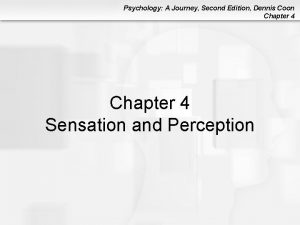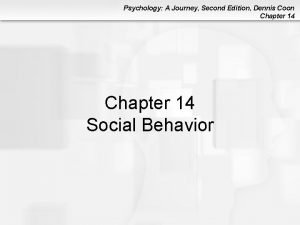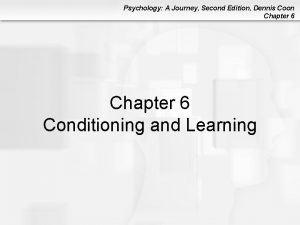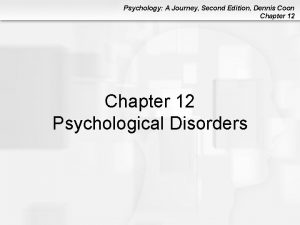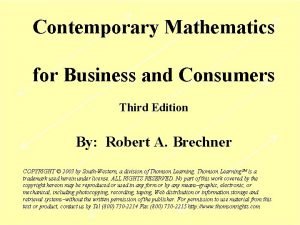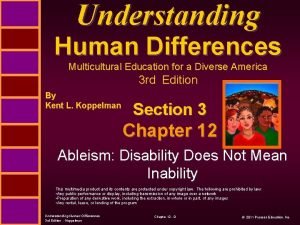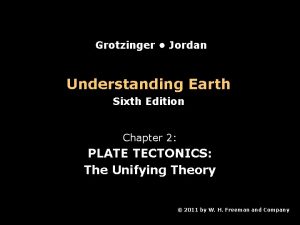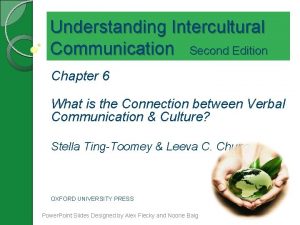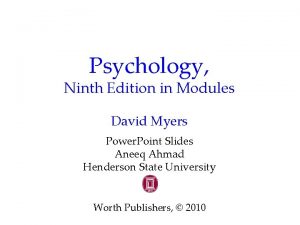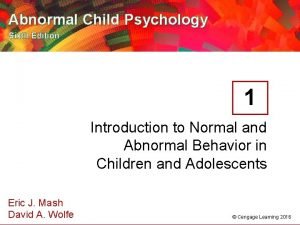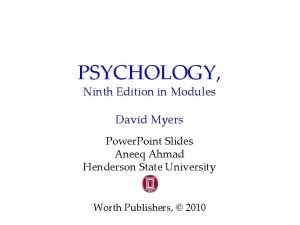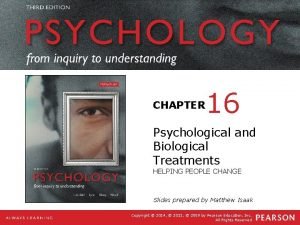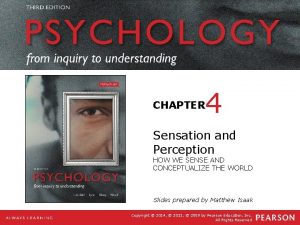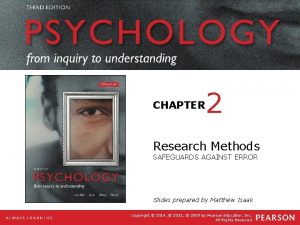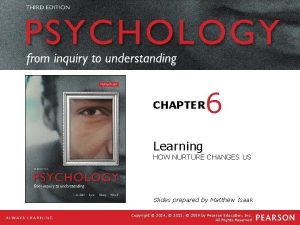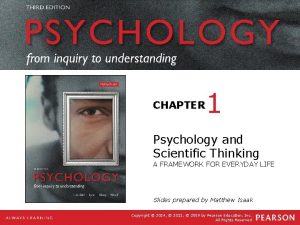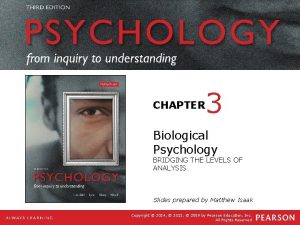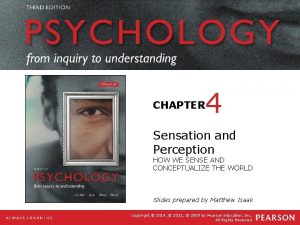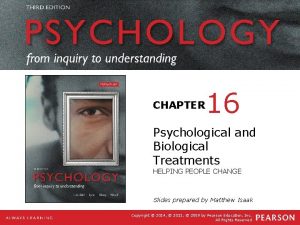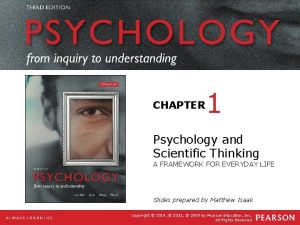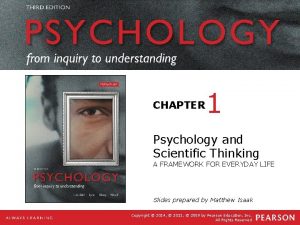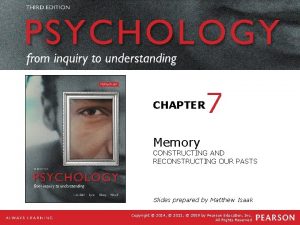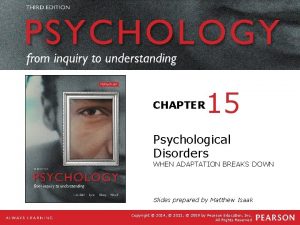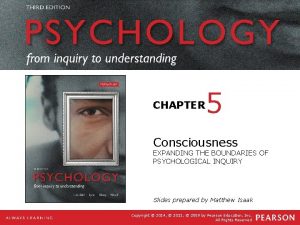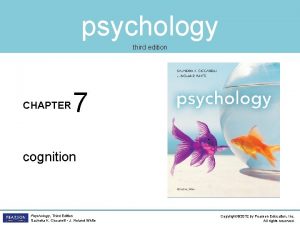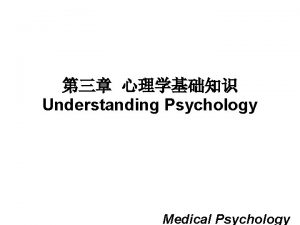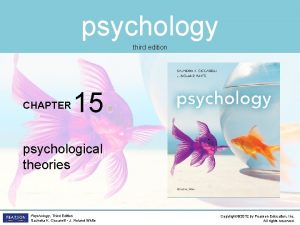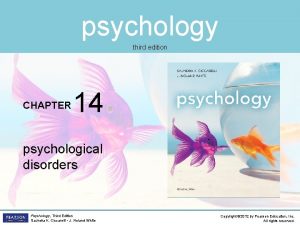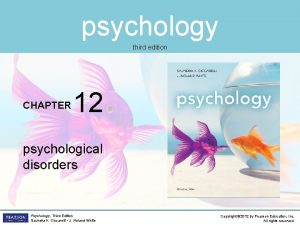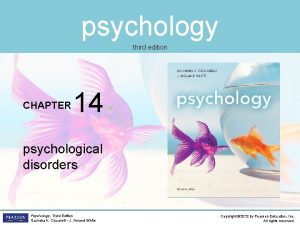THIRD EDITION PSYCHOLOGY from inquiry to understanding CHAPTER









































- Slides: 41

THIRD EDITION PSYCHOLOGY from inquiry to understanding CHAPTER 14 Personality WHO WE ARE Slides prepared by Matthew Isaak Copyright © 2014, © 2011, © 2009 by Pearson Education, Inc. All Rights Reserved

Personality LO 14. 1 Describe how twin and adoption studies shed light on genetic and environmental influences on personality. • Relatively enduring predispositions that influence our behavior across many situations • These traits account in part for consistencies in our behavior across time and situations. • Nomothetic vs. idiographic approaches to studying personality Understanding Psychology: from Inquiry to Understanding , Third Edition Lilienfeld | Lynn | Namy | Woolf

Causes of Personality LO 14. 1 Describe how twin and adoption studies shed light on genetic and environmental influences on personality. • Behavior-genetic methods try to disentangle the effects of: – Genetic factors – Shared environmental factors – Nonshared environmental factors • Use twin and adoption studies to do this Understanding Psychology: from Inquiry to Understanding , Third Edition Lilienfeld | Lynn | Namy | Woolf

A Note of Caution LO 14. 1 Describe how twin and adoption studies shed light on genetic and environmental influences on personality. • Remember, genes code for proteins, not specific behaviors. • Genes have indirect influence on traits, while the environment influences how these are displayed in our lives Understanding Psychology: from Inquiry to Understanding , Third Edition Lilienfeld | Lynn | Namy | Woolf

Sigmund Freud LO 14. 2 Describe the core assumptions of psychoanalytic theory. • Viennese neurologist who developed first comprehensive theory of personality Understanding Psychology: from Inquiry to Understanding , Third Edition Lilienfeld | Lynn | Namy | Woolf

Psychoanalytic Theory LO 14. 2 Describe the core assumptions of psychoanalytic theory. • Developed by Sigmund Freud • Rests on three primary assumptions: 1. Psychic determinism 2. Symbolic meaning 3. Unconscious motivation Understanding Psychology: from Inquiry to Understanding , Third Edition Lilienfeld | Lynn | Namy | Woolf

Figure 14. 1 Freud's Model of Personality Structure. According to some authors, Freud’s conception of personality is analogous to an iceberg, with the conscious mind being the tip barely visible above the surface and the unconscious being the vast submerged area entirely underwater. Nevertheless, we shouldn’t take the iceberg metaphor too literally (indeed, Freud himself apparently never used it), because according to Freud, different aspects of personality are in constant interaction. Understanding Psychology: from Inquiry to Understanding , Third Edition Lilienfeld | Lynn | Namy | Woolf

Structure of Personality LO 14. 2 Describe the core assumptions of psychoanalytic theory. • Freud thought that the psyche consisted of three components: – Id – basic instincts; operates on pleasure principle – Ego – principal decision maker; operates on reality principle – Superego – sense of morality • Conflict between these causes distress. Understanding Psychology: from Inquiry to Understanding , Third Edition Lilienfeld | Lynn | Namy | Woolf

Figure 14. 2 Id, Ego, and Superego. Many works of art portray an individual trying to make a difficult moral decision with a devil on one shoulder—urging immoral behavior—and an angel—urging moral behavior—on the other. Freudians would say that such artwork captures the distinction among ego (the person trying to make the decision), id (demon), and superego (angel). Understanding Psychology: from Inquiry to Understanding , Third Edition Lilienfeld | Lynn | Namy | Woolf

Psychoanalytic Theory LO 14. 2 Describe the core assumptions of psychoanalytic theory. • Freud thought that our dreams reflected this unconscious struggle. • Said all dreams reflected wish fulfillments but that some were in disguise. • Contrary to pop psych, did not say that all symbols mean the same to everyone Understanding Psychology: from Inquiry to Understanding , Third Edition Lilienfeld | Lynn | Namy | Woolf

Anxiety and Defense Mechanisms LO 14. 2 Describe the core assumptions of psychoanalytic theory. • The ego will try to minimize anxiety via defense mechanisms. • Although essential for psychological health, Freud thought over-reliance on one or two could cause problems Understanding Psychology: from Inquiry to Understanding , Third Edition Lilienfeld | Lynn | Namy | Woolf

Defense Mechanism Examples LO 14. 2 Describe the core assumptions of psychoanalytic theory. • Repression – motivated forgetting of emotionally threatening memories or impulses • Denial – motivated forgetting of distressing experiences • Projection – unconscious attribution of our negative qualities to others Understanding Psychology: from Inquiry to Understanding , Third Edition Lilienfeld | Lynn | Namy | Woolf

Stages of Psychosexual Development LO 14. 2 Describe the core assumptions of psychoanalytic theory. • Freud believed that we pass through stages, each of which is focused on an erogenous zone. • Freud insisted that sexuality begins in infancy. • Individuals may get fixated in a stage and have difficulty moving on. Understanding Psychology: from Inquiry to Understanding , Third Edition Lilienfeld | Lynn | Namy | Woolf

Table 14. 5 Freud's Stages of Psychosexual Development. Understanding Psychology: from Inquiry to Understanding , Third Edition Lilienfeld | Lynn | Namy | Woolf

Scientific Evaluation LO 14. 3 Describe key criticisms of psychoanalytic theory and the central features of neo-Freudian theories. • Very influential in our thinking about personality, but there are major criticisms: – Unfalsifiable – Failed predictions – Questionable conception of unconscious – Unrepresentative samples – Emphasis on shared environment Understanding Psychology: from Inquiry to Understanding , Third Edition Lilienfeld | Lynn | Namy | Woolf

Neo-Freudians LO 14. 3 Describe key criticisms of psychoanalytic theory and the central features of neo-Freudian theories. • Differ from Freud's theories in two key ways: – Less emphasis on sexuality, more on social drives – More optimistic about personal growth • Adler's style of life and inferiority complex • Jung's collective unconscious and archetypes Understanding Psychology: from Inquiry to Understanding , Third Edition Lilienfeld | Lynn | Namy | Woolf

Behavioral Approaches LO 14. 4 Identify the core assumptions of behavioral and social learning theories of personality. • Believe that differences in our personalities stem largely from our learning histories • Personalities are bundles of habits acquired by classical and operant conditioning. • View personality as under the control of genetic factors and contingencies Understanding Psychology: from Inquiry to Understanding , Third Edition Lilienfeld | Lynn | Namy | Woolf

Social Learning Theories LO 14. 4 Identify the core assumptions of behavioral and social learning theories of personality. • See learning as important, but believe thinking to play a crucial role as well • Emphasize reciprocal determinism rather than Skinnerian determinism • Focus on observational learning and individuals' locus of control Understanding Psychology: from Inquiry to Understanding , Third Edition Lilienfeld | Lynn | Namy | Woolf

Humanistic Models of Personality LO 14. 6 Explain the concept of self-actualization and its role in humanistic models. • Carl Rogers rejected the notion of determinism and embraced free will. • Proposed selfactualization as core motive in personality Understanding Psychology: from Inquiry to Understanding , Third Edition Lilienfeld | Lynn | Namy | Woolf

Roger's Model LO 14. 6 Explain the concept of self-actualization and its role in humanistic models. • Three major components of personality: 1. The organism (innate, genetic blueprint) 2. The self (set of beliefs about who we are) 3. Conditions of worth (expectations we place on ourselves – can result in incongruence) Understanding Psychology: from Inquiry to Understanding , Third Edition Lilienfeld | Lynn | Namy | Woolf

Self-Actualization LO 14. 6 Explain the concept of self-actualization and its role in humanistic models. • Maslow said that self-actualized people tend to be creative, spontaneous, and accepting of themselves and others. • May seem difficult to work with or aloof • Prone to peak experiences Understanding Psychology: from Inquiry to Understanding , Third Edition Lilienfeld | Lynn | Namy | Woolf

Trait Models LO 14. 8 Describe trait models of personality, including the Big Five. • Interested primarily in describing and understanding the structure of personality • Used factor analysis to reduce diversity of personality descriptors to underlying traits Understanding Psychology: from Inquiry to Understanding , Third Edition Lilienfeld | Lynn | Namy | Woolf

Big Five Model LO 14. 8 Describe trait models of personality, including the Big Five. • Five traits have repeatedly appeared in such studies: – Conscientiousness – Agreeableness – Neuroticism – Openness to Experience – Extraversion Understanding Psychology: from Inquiry to Understanding , Third Edition Lilienfeld | Lynn | Namy | Woolf

Big Five and Behavior LO 14. 8 Describe trait models of personality, including the Big Five. • Predict many important real-world behaviors – Job performance and grades in school – Physical health and life span • Relatively similar traits seen across cultures, but different prevalence rates – Individualist vs collectivistic societies Understanding Psychology: from Inquiry to Understanding , Third Edition Lilienfeld | Lynn | Namy | Woolf

Tendencies vs Adaptations LO 14. 8 Describe trait models of personality, including the Big Five. • Basic tendencies are underlying personality traits; characteristic adaptations are their behavioral manifestations • Same trait can manifest in very different ways. – Sensation seeking in firefighters and criminals Understanding Psychology: from Inquiry to Understanding , Third Edition Lilienfeld | Lynn | Namy | Woolf

Can Personality Change? LO 14. 8 Describe trait models of personality, including the Big Five. • Some variability prior to age 30, but little thereafter • Some evidence for changing of personality psychopharmacologically, but should we? Understanding Psychology: from Inquiry to Understanding , Third Edition Lilienfeld | Lynn | Namy | Woolf

Scientific Evaluation LO 14. 9 Identify key criticisms of trait models. • Mischel's argument concerning behavioral inconsistency • Response was that traits are predictors of aggregate, not isolated, behaviors • Primarily describe individual differences rather than what causes them Understanding Psychology: from Inquiry to Understanding , Third Edition Lilienfeld | Lynn | Namy | Woolf

Personality Assessment LO 14. 10 Describe structured personality tests such as the MMPI-2 and their methods of construction. • Plagued by number of dubious methods: – Phrenology (head shape) – Physiognomy (facial characteristics) – Sheldon's body types • All lacked two key criteria – reliability and validity Understanding Psychology: from Inquiry to Understanding , Third Edition Lilienfeld | Lynn | Namy | Woolf

Structured Personality Tests LO 14. 10 Describe structured personality tests such as the MMPI-2 and their methods of construction. • Paper-and-pencil tests consisting of questions you answer in one of a few fixed ways • The Minnesota Multiphasic Personality Inventory (MMPI) is the most researched test. – 567 true-false questions – 10 basic scales Understanding Psychology: from Inquiry to Understanding , Third Edition Lilienfeld | Lynn | Namy | Woolf

MMPI LO 14. 10 Describe structured personality tests such as the MMPI-2 and their methods of construction. • Developed using empirical method of test construction, so it has low face validity Understanding Psychology: from Inquiry to Understanding , Third Edition Lilienfeld | Lynn | Namy | Woolf

MMPI LO 14. 10 Describe structured personality tests such as the MMPI-2 and their methods of construction. • Contains three validity scales designed to detect various types of distorted responses: – L (Lie) detects impression management. – F (Frequency) detects malingering. – K (Correction) measures defensive responding. Understanding Psychology: from Inquiry to Understanding , Third Edition Lilienfeld | Lynn | Namy | Woolf

Figure 14. 5 An MMPI-2 Profile. MMPI-2 scores of 50 are average, and scores of 65 or above are abnormally high. This individual received elevated scores on several MMPI-2 clinical scales, namely, Hs (Hypochondriasis), D (Depression), Hy (Hysteria), Pt (Psychasthenia—Anxiety), and Sc (Schizophrenia), suggesting high levels of physical and mental anxiety, sad mood, and disturbed thinking. (Source: Adapted from the MMPI®-2 (Minnesota Multiphasic Personality Inventory®-2) Manual for Administration, Scoring, and Interpretation , Revised Edition. Copyright © 2001 by the Regents of the University of Minnesota. Used by permission of the University of Minnesota Press. All rights reserved. “MMPI-2” and “Minnesota Multiphasic Personality Inventory-2” are trademarks owned by the Regents of the University of Minnesota. ) Understanding Psychology: from Inquiry to Understanding , Third Edition Lilienfeld | Lynn | Namy | Woolf

MMPI Evaluated Scientifically LO 14. 10 Describe structured personality tests such as the MMPI-2 and their methods of construction. • Most scales are both reliable as well as valid for differentiating among mental disorders. • Problematic in several ways: – Redundant scales – Not used formal diagnosis – Scales can be misused. Understanding Psychology: from Inquiry to Understanding , Third Edition Lilienfeld | Lynn | Namy | Woolf

Rational/Theoretical Method LO 14. 10 Describe structured personality tests such as the MMPI-2 and their methods of construction. • Requires test developers to begin with a clear-cut conceptualization of a trait and then write items to assess that conceptualization • Some have strong reliability and validity (NEO PI-R) but others do not (Myers-Briggs). • The NEO PI-R assesses the Big Five personality six subordinate dimensions. Understanding Psychology: from Inquiry to Understanding , Third Edition Lilienfeld | Lynn | Namy | Woolf

Projective Tests LO 14. 11 Describe projective tests, particularly the Rorschach, and their strengths and weaknesses. • Ask examinees to interpret or make sense of ambiguous stimuli • Based on projective hypothesis: – When interpreting ambiguous stimuli, people project aspects of their personality onto them. • Controversial, because reliability and validity are in dispute Understanding Psychology: from Inquiry to Understanding , Third Edition Lilienfeld | Lynn | Namy | Woolf

Rorschach Inkblot Test LO 14. 11 Describe projective tests, particularly the Rorschach, and their strengths and weaknesses. • Ten symmetrical inkblots, five blackand-white and five with color • Respondents say what each inkblot resembles. • This supposedly reveals respondent's traits. Understanding Psychology: from Inquiry to Understanding , Third Edition Lilienfeld | Lynn | Namy | Woolf

Figure 14. 6 An Inkblot Similar to That on the Rorschach Inkblot Test. Although widely used, the Rorschach appears not to possess the magical powers often attributed to it by its most enthusiastic proponents. Understanding Psychology: from Inquiry to Understanding , Third Edition Lilienfeld | Lynn | Namy | Woolf

Rorschach: Scientific Evaluation LO 14. 11 Describe projective tests, particularly the Rorschach, and their strengths and weaknesses. • Unknown test-retest and problematic interrater reliability scores • Little evidence that it detects features of mental disorders • Lack of incremental validity Understanding Psychology: from Inquiry to Understanding , Third Edition Lilienfeld | Lynn | Namy | Woolf

Thematic Apperception Test LO 14. 11 Describe projective tests, particularly the Rorschach, and their strengths and weaknesses. • Requires subject to construct a story based on pictures • Little evidence for adequate reliability or validity for most applications Understanding Psychology: from Inquiry to Understanding , Third Edition Lilienfeld | Lynn | Namy | Woolf

Other Projective Tests LO 14. 11 Describe projective tests, particularly the Rorschach, and their strengths and weaknesses. • Human figure drawing tests require you to draw a person(s) in any way you wish. • Graphology – analysis of handwriting – is another projective test. • Neither has scientific support. Understanding Psychology: from Inquiry to Understanding , Third Edition Lilienfeld | Lynn | Namy | Woolf

Pitfalls in Personality Assessment LO 14. 12 Identify common pitfalls in personality assessment. • The PT Barnum effect and the tendency to accept high base rate descriptors as accurate – Astrology and tarot readings • Overall, personality assessment can be useful, but only if using valid, reliable instruments. Understanding Psychology: from Inquiry to Understanding , Third Edition Lilienfeld | Lynn | Namy | Woolf
 Adler and rodman 2006
Adler and rodman 2006 Business essentials 12th edition free
Business essentials 12th edition free Mount and hume classification
Mount and hume classification Mount and hume classification
Mount and hume classification Psychology fifth edition ciccarelli white
Psychology fifth edition ciccarelli white Psychology a journey 4th edition chapter 1
Psychology a journey 4th edition chapter 1 Psychology a journey 4th edition chapter 1
Psychology a journey 4th edition chapter 1 Psychology a journey 4th edition chapter 1
Psychology a journey 4th edition chapter 1 Psychology a journey 4th edition chapter 1
Psychology a journey 4th edition chapter 1 Principle of management oxford fajar pdf
Principle of management oxford fajar pdf Carboxylic acid h3o+ reaction
Carboxylic acid h3o+ reaction Organic chemistry third edition david klein
Organic chemistry third edition david klein Business mathematics third edition
Business mathematics third edition Distributed systems third edition
Distributed systems third edition Fundamentals of corporate finance third canadian edition
Fundamentals of corporate finance third canadian edition Sujata madan
Sujata madan Lifespan development third edition
Lifespan development third edition Lifespan development third edition
Lifespan development third edition Essential cell biology
Essential cell biology Dr ruth yates
Dr ruth yates Understanding nutrition 13th edition rental
Understanding nutrition 13th edition rental Copyright
Copyright Understanding human differences 5th edition
Understanding human differences 5th edition Understanding earth 7th edition
Understanding earth 7th edition Folded mountains
Folded mountains Understanding earth 5th edition
Understanding earth 5th edition Understanding human communication 14th edition
Understanding human communication 14th edition Understanding earth 6th edition
Understanding earth 6th edition Understanding intercultural communication 2nd edition
Understanding intercultural communication 2nd edition Mis chapter 6
Mis chapter 6 Using mis (10th edition)
Using mis (10th edition) Examples of altruism
Examples of altruism Father of humanistic psychology
Father of humanistic psychology Psychology understanding standards
Psychology understanding standards Levels of analysis psychology
Levels of analysis psychology Psychology ninth edition in modules
Psychology ninth edition in modules Psychology eighth edition david g myers
Psychology eighth edition david g myers Abnormal child psychology 6th edition
Abnormal child psychology 6th edition Psychology eighth edition david g myers
Psychology eighth edition david g myers Lysanx
Lysanx General adaptation syndrome
General adaptation syndrome Social psychology ninth edition
Social psychology ninth edition





